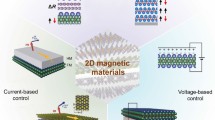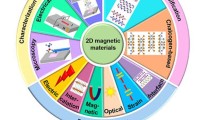Abstract
Molecular-based conducting magnet or magnetic conductor, is an overlap of organic conductor and molecular magnet. Due to the existence of ferromagnetism, antiferromagnetism and quantum magnetism in insulated charge-transfer salt, it becomes a common sense that magnetism is not good for conductivity. After the discovery of first molecular-based metallic ferromagnet, molecular-based conducting magnet with π-unit from organic conductor and magnetism from coordination counterion became a hot area. The metallic ferromagnet, semiconductor room-temperature ferrimagnet, metallic weak ferromagnet and superconducting antiferromagnet have been discovered. The new molecular-based conducting magnet with higher conductivity and higher magnetic ordering temperature is expected.
Similar content being viewed by others
References
Wiki, “magnet”
Singleton J. Why do physicists love charge-transfer salts? J Solid State Commun, 2001, 168: 675–689
Palacio F, Miller JS. A dual-action material. Nature, 2000, 408: 421–422
Coronado E, Day P. Magnetic molecular conductors. Chem Rev, 2004, 104: 5419–5448
Cassoux P. A molecular paramagnetic superconductor. Science, 1997, 272: 1277–1278
See, The super century. Nat Mater, 2011, 10: 253–263
Watanabe T, Yanai H, Kamiya T, Kamihara Y, Hisamatsu H, Hirano M, Hosono H. Nickel-based oxyphosphide superconductor with a layered crystal structure, LaNiOP. Inorg Chem, 2007, 46: 7719–7721
Kamihara Y, Hiramatsu H, Hirano M, Kawamura R, Yanagi H, Kamiya T, Hosono H. Iron-based layered superconductor: LaOFeP. J Am Chem Soc, 2006, 128: 10012–10013
Kamihara Y, Watanabe T, Hirano M, Hosono H. Iron-based layered superconductor La[O1−x Fx]FeAs (x = 0.05 − 0.12) with T c = 26 K. J Am Chem Soc, 2008, 130: 3296–3297
Hanna T, Muraba Y, Matsuishi S, Igawa N, Kodama K, Shamoto S, Hosono H. Superconductivity and fluctuating magnetism in quasi-two-dimensional κ-(BEDT-TTF)2Cu[N(CN)2]Br probed with implanted muons. Phy Rev B, 2011, 83: 024521
Lehn JM. Supramolecular Chemistry. Wiely-VCH, 1995
Akamatu H, Inokuchi H, Matsunaga Y. Electrical conductivity of the perylene-bromine complex. Nature, 1954, 193: 168–169
Shirakawa H, Louis EJ, MacDiarmid AG, Chiang CK, Heeger AJ. Synthesis of electrically conducting organic polymers halogen derivatives of polyacetylene, (CH)x. J Chem Soc Chem Commun, 1977, 578-580
Ferraris J, Cowan DO, Waltka W, Peristein JH. Electron transfer in a new highly conducting donor-acceptor complex. J Am Chem Soc, 1973, 95: 948–949
Jerome D, Mazaud A, Ribault M, Bechgaards K. Superconductivity in a synthetic organic conductor (TMTSF)2PF6. J Physique Lett, 1980, 41: L95–L98
Williams JM, Ferraro JR, Thorn RJ, Carlson KD, Geiser U, Wang HH, Kini AM, Whangbo M. Organic Superconductors (Including Fullerenes). Englewood Cliffs: Prentice Hall Inc., 1992
Taniguchi H, Miyashita M, Uchiyama K, Satoh K, Mori N, Okamoto H, Miyagawa K, Kanoda K, Hedo M, Uwatoko Y. Superconductivity at 14.2 K in layered organics under extreme pressure. J Phy Soc Jpn, 2003, 72: 468–471
Takayashi Y, Ganin AY, Jeglic P, Arcon D, Takano T, Iwasa Y, Ohishi Y, Takata M, Takeshita N, Prassides K, Rosseinsky MJ. The disorder-free non-BCS superconductor Cs3C60 emerges from an antiferromagnetic insulator parent state. Science, 2009, 323: 1585–1590
Mizuno M, Garito AF, Cava MP. “Organic metals”: Alkylthio substitution effects in tetrathiafulvalene-tetracyanoquinodimethane charge -transfer complexes. J Chem Soc, Chem Commun, 1978, 18–19
Williams JM. Highly conducting and superconducting synthetic metals. Inorg Synth, 1989, 26: 386–390
Yu HB, Zhang B, Zhu DB, New organic charge transfer salts (ET)4(FeCl4)2 and (ET)FeCl4: Preparation, structure, XP spectra and electrical properties. J Mater Chem, 1998, 8: 77–80
Zhang B, Wang ZM, Fujiwara H, Kobayashi H, Kurmoo M, Inoue K, Mori T, Gao S, Zhang Y, Zhu DB. Tetrathiafulvalene [FeIII(C2O4)Cl2 −]: An organic-inorganic hybrid exhibiting canted antiferromagnetism. Adv Mater, 1995, 17: 1988–1991
Wang HH, Williams JM. Ambient-pressure superconducing synthetic metals β-(BEDT-TTF)2X, X = I −3 , IBr −2 , and AuI −2 . Inorg Synth, 1992, 29: 41–50
Zhang B, Yao YX, Zhu DB. A new organic conductor (BEDT-TTF)5Cl3(H2O)5. Synth Met, 2001, 120: 671–674
Zhang B, Kurmoo M, Mori T, Zhang Y. Pratt, FL, Zhu DB, Polymorphism in hybrid organic-inorganic bilayered magnetic conductors (BEDT-TTF)3(FeIIICl4)2, BEDT-TTF = bis(ethylenedithio) tetrathiafulvalene. Cryst Growth Des, 2010, 10: 782–789
Mallah T, Hollis C, Bott S, Kurmoo M, Day P. Crystal structures and physical properties of bis(ethylenedithi0)-tetrathiafulvalene chargetransfer salts with FeX4 − (X = CI or Br) anions. J Chem Soc, Dalton Trans, 1990, 859–865
BEDT-TTF(FeCl4)2, cell parameter: a = 6.2080(7) Å, b = 11.0048(3) Å, c = 19.3051(14) Å, β = 92.918(2)°, V = 1317.2(2) Å3, Z = 2, P21/n
Miyagawa K, Kanoda K, Kawamoto A. NMR studies on two-dimensional molecular conductors and superconductors: Mott transition in κ-(BEDT-TTF)2X. Chem Rev, 2004, 104: 5635–5653
Geiser U, Wang HH, Donega KM, Anderson BA, Williams JM, Kwak JF. Synthesis, electrical properties, and crystal structure of the first organic metal-solid electrolyte hybrid: (BEDT-TTF)3AgxI8 (x.apprx. 6.4). Inorg Chem, 1986, 25: 402–403
Zhang B, Zhang Y, Zhu DB. (BEDT-TTF)3Cu2(C2O4)3(CH3OH)2: An organic-inorganic hybrid antiferromagnetic semiconductor. Chem Commun, 2012, 48: 197–199
Graham AW, Kurmoo, M, Day P. β″-(bedt-ttf)4[(H20) Fe(C204)3].PhCN: the first molecular superconductor containing paramagnetic metal ions. J Chem Soc, Chem Commun, 1995, 2061–2062
Coronado E, Curreli S, Gimenez-Saiz C, Gomez-Garcia CJ. A novel paramagnetic molecular superconductor formed by bis (ethylenedithio)tetrathiafulvalene, tris(oxalato)ferrate(III) anions and bromobenzene as guest molecule: ET4[(H3O)Fe(C2O4)3]·C6H5Br. J Mater Chem, 2005, 15: 1429–1436
Guionneau P, Kepert CJ, Bravic G, Chasseau D, Truter MR, Kurmoo M, Day P. Determining the charge distribution in BEDT-TTF salts. Synth Metal, 1997, 86: 1973–1974
Wang HH, Ferraro JR, Williams JM, Geiser U, Schlueter JA. Rapid raman spectroscopic determination of the stoichiometry of microscopic quantities of BEDT-ITF-based organic conductors and superconductors. J Chem Soc, Chem Commun, 1994, 1893–1894
Coulon C, Clerac R. Electron spin resonance: A major probe for molecular conductors. Chem Rev, 2004, 104: 5655–5687
Seo H, Hotta C, Fukuyama H. Toward systematic understanding of diversity of electronic properties in low-dimensional molecular solids. Chem Rev, 2004, 104: 5005–5036
Lefebvre S, Wzietek P, Brown S, Bourbonnais C, Jerome D, Mezicre C, Fourimigue M, Batail P. Mott transition, antiferromagnetism, and unconventional superconductivity in layered organic superconductors. Phys Rev Lett, 2000, 85: 5420–5423
Coomber AT, Beljonne D, Friend RH, Bredas JL, Charlton A, Robertson N, Underhill AE, Kurmoo M, Day P. Intermolecular interactions in the molecular ferromagnetic NH4Ni(mnt)2·H2O. Nature, 1996, 380: 144–146
Shimizu Y, Miyagawa K, Kanoda K, Maesato M, Saito G. Spin liquid state in an organic mott insulator with a triangular lattice. Phy Rev Lett, 2003, 91: 107001
Yamashita S, Nakazawa Y, Oguni M, OShima Y, Nojiri H, Shimizu Y, Miyagawa K, Kanoda K. Thermodynamic properties of a spin-1/2 spin-liquid state in a κ-type organic salt. Nat Phys, 2008, 4: 459–462
Yamashita M, Nakata N, Senshu Y, Nagata M, Yamamoto HM, Kato R, Shibauchi T, Matsuda Y. Highly mobile gapless excitations in a two-dimensional candidate quantum spin liquid. Science, 2010, 328: 1246–1248
Pratt FL, Baker PJ, Blundell SJ, Lancaster T, Ohira-Kawamura S, Baines C, Shimatzu Y, Kanoda K, Watanabe I, Saito G. Magnetic and non-magnetic phases of a quantum spin liquid. Nature, 2011, 471: 612–616
Bonniface DW, Braithwaite MJ, Eley DD, Evans RG, Pethig R, Willis MR. Factors affecting conduction in polymeric complex TCNQ salts. Discussions of the Faraday Society, 1971, 51: 131–138
Manriquez JM, Yee GT, McLean RS, Epstein AJ, Miller JS. A room-temperature molecular/organic-based magnet. Science, 1991, 252: 1415–1417
Carlegrim E, Kancirurzewska A, Nordblad P, Fahlman M. Air-stable organic-based semiconducting room temperature thin film magnet for spintronics applications. Appl Phy Lett, 2008, 92: 163308
Lopez N, Zhao H. Ota A, Prosvirin AV, Reinheimer EW, Dunbar KR. Unprecedented binary semiconductors based on TCNQ: Singlecrystal x-ray studies and physical properties of Cu(TCNQX2) X = Cl, Br. Adv Mater, 2010, 22: 986–989
Chifotides HT, Schottel BL, Dunbar KR. The π-Accepting arene HAT(CN)6 as a halide receptor through charge transfer: Multisite anion interactions and self-assembly in solution and the solid state. Angew Chem Int Ed, 2010, 49: 7202–7207
Miyasaka H, Motokawa N, Matsunaga S, Yamashita M, Sugimoto K, Mori T, Toyota N, Dunbar KR. Control of charge transfer in a series of Ru2 II,II/TCNQ two-dimensional networks by tuning the electron affinity of TCNQ units: A route to synergistic magnetic/conducting materials. J Am Chem Soc, 2010, 132: 1532–1544
Edwards PR, Johnson CE. Mössbauer hyperfine interactions in tetrahedal Fe(III) ions. J Chem Phys, 1968, 49: 211–216
Tamaki H, Zhong ZJ, Matsumoto N, Kida S, Koikawa M, Achiwa N, Hashimoto Y, Okawa H. Design of metal-complex magnets. Syntheses and magnetic properties of mixed-metal assemblies {NBu4[MCr( OX)3]]}x ( NBu4 + = Tetra(n-buty1) ammonium ion; ox2− = oxalate ion; M = Mn2+, Fe2+, Co2+, Ni2+, Cu2+, Zn2+). J Am Chem Soc, 1992, 114: 6974–6979
Wang XY, Wang ZM, Gao S. Constructing magnetic molecular solids by employing three-atom ligands as bridges. Chem Commun, 2008, 281–294
Day P, Kurmoo M, Mallah T, Marsden IR, Friend RH, Pratt FL, Hayes W, Chasseau D, Gaultier J, Bravic G, Ducasse L. Structure and properties of tris[bis(ethylenedithio)tetrathiafulvalenium]te trachlorocopper( II ) hydrate, (BEDT-TTF)3CuC14·H2O: First evidence for coexistence of localized and conduction electrons in a metallic charge-transfer salt. J Am Chem Soc, 1992, 114: 10722–10729
Kobayashi H, Tomita H, Naito T, Kobayashi A, Sakai F, Watanabe T, Cassoux P. New BETS conductors with magnetic anions (BETS) = bis(ethylenedithio)tetraselenafulvalene). J Am Chem Soc, 1996, 118: 369–377
Uji S, Shinagawa H, Terashima T, Yakabe T, Terai Y, Tokumoto M, Kobayashi A, Tanaka H, Kobayashi H. Magnetic-field-induced superconductivity in a two-dimensional organic conductor. Nature, 2001, 410: 908–910
Kobayashi H, Cui HB, Kobayashi A. Organic metals and superconductors based on BETS (BETS = bis(ethylenedithio)tetraselenafulvalene). Chem Rev, 2004, 104: 5265–5288
Coronado E, Galan-Mascaros J, Gomez-Garcia CJ, Laukhin V. Coexistence of ferromagnetism and metallic conductivity in a moleculebased layered compound. Nature, 2000, 408: 447–449
Zhang B, Wang ZM, Zhang Y, Takahashi K, Okano Y, Cui HB, Kobayashi H, Inoue K, Kurmoo M, Pratt FL, Zhu DB. Hybrid organic-inorganic conductor with a magnetic chain anion: κ-BETS2[FeIII(C2O4)Cl2 −] [BETS = bis(ethylenedithio)tetraselenafulvalene]. Inorg Chem, 2006, 45: 3275–3280
Zhang B, Pratt FL, Kurmoo M, Okano Y, Kobayashi H, Zhu DB. A hybrid organic-inorganic conductor κ′-BETS2FeCl4, BETS = bis(ethylenedithio)tetraselenafulvalene). Crys Growth Design, 2007, 7: 2548–2552
Xu HB, Liu T, Wang ZM, Gao S. Synthesis, structure, and magnetic properties of (A)[FeIII(oxalate)Cl2] (A = alkyl ammonium cations) with anionic 1D [FeIII(oxalate)Cl2]− chains. Inorg Chem, 2007, 46: 3089–3096
Hiraga H, Miyasaka H, Clerac R, Fourmigue M, Yamashita M. MIII(dmit)2]−-coordinated MnIII salen-type dimers (MIII = NiIII, AuIII; dmit2− = 1,3-dithiol-2-thione-4,5-dithiolate): Design of single-component conducting single-molecule magnet-based materials. Inorg Chem, 2009, 48: 2887–2898
Takahashi K, Cui HB, Okano Y, Kobayashi H, Mori H, Tajima H, Einaga Y, Sato O. Evidence of the chemical uniaxial strain effect on electrical conductivity in the spin-crossover conducting molecular system: [FeIII(qnal)2][Pd(dmit)2]5· acetone. J Am Chem Soc, 2008, 130: 6688–6689
Djukic B, Lemaire M. Hybrid spin-crossover conductor exhibiting unusual variable-temperature electrical conductivity. Inorg Chem, 2009, 48: 10489–10491
Tanaka H, Okano Y, Kobayashi H, Suzuki W, Kobayashi A. A three-dimensional synthetic metallic crystal composed of single-component molecules. Science, 2001, 291: 285–287
Zhou B, Shimamura M, Fujiwara H, Kobayashi A, Higashi T, Nishibori E, Sakata M, Cui HB, Takahashi K, Kobayashi H. Magnetic transitions of single-component molecular metal [Au(tmdt)2] and its alloy systems. J Am Chem Soc, 2006, 128: 3872–3873
Zhou B, Kobayashi A, Okano Y, Cui HB, Graf D, Brooks JS, Nakashima T, Aoyagi S, Nishibori E, Sakata M. Structural anomalies associated with antiferromagnetic transition of single-component molecular metal [Au(tmdt)2]. Inorg Chem, 2009, 48: 10151–10157
Jia CY, Liu SX, Ambrus C, Neels A, Labat G, Decurtins S. One-dimensional µ-chloromanganese(II)-tetrathiafulvalene (TTF) coordination compound. Inorg Chem, 2006, 45: 3152–3154
Ya C, Li C, Wang C, Wu D, Zuo J, You X. Synthesis, structure and physical properties of the one-dimensional chain complex of tetrathiafulvalene carboxylate. Sci China Ser B-Chem, 2009, 52: 1596–1601
McKenzie RH. Similarities between organic and cuprate superconductors. Science, 1997, 278: 820–821
Author information
Authors and Affiliations
Corresponding authors
Rights and permissions
About this article
Cite this article
Zhang, B., Zhu, D. Molecular-based conducting magnet. Sci. China Chem. 55, 883–892 (2012). https://doi.org/10.1007/s11426-012-4568-z
Received:
Accepted:
Published:
Issue Date:
DOI: https://doi.org/10.1007/s11426-012-4568-z




